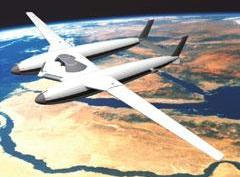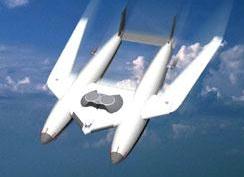
Wind turbines take flight
Pass Christian, Miss.
Hunt Aviation's presentation of its new gravity powered aircraft technology
to the public and to the aviation industry for the first time at the National
Business Aviation Association Convention in Orlando, FL was a tremendous
success, according to Mr. Gene Cox, President of Hunt Aviation.
"The main advantages that we have over other aircraft technologies
are that we can stay airborne indefinitely because of our aerostatic lift
capabilities and we do not need fuel in order to fly," Cox stated.
"Also, we can land on water and maneuver as a boat after landing
or we can set down on any relatively flat surface, having vertical take-off
and landing capabilities. Currently, we are in discussion with aviation
industry strategic partners in regards to jointly bidding to build new
aircraft prototypes for the nation's armed forces with dramatic new capabilities,
such as no heat signature, no radar detection, no onboard fuel to combust
or explode, and heavy lift capacity."

The gravityplane, as the new hybrid aircraft is called, was created by inventor, Robert Hunt. His invention is the first practical use of gravity to provide a motive force by creating a continuous cycle out of two forces of gravity: (1) buoyancy as an upward force caused by the greater gravitational pull of the earth on the surrounding atmosphere than on the lighter helium gas within the aircraft to gain potential energy of height; and, (2) gravity acceleration to provide downward and forward gliding thereby converting the potential energy of height into kinetic energy of motion—with the result being, for the first time ever, self-sustained fuel-less flight.
The gravityplane can switch back and forth from being lighter-than-air in order to gain altitude or to being heavier-than-air to become a glider by respectively exhausting compressed air that serves as ballast weight to become lighter or by bringing in compressed air to add weight.
How the gravityplane works: (1) lighter-than-air (aerostatic) lift—inert
helium gas fills gas-bags enclosed within a rigid lightweight aircraft
to gain altitude; and, (2) loss of lift—air from the surrounding
atmosphere is compressed into the aircraft to cause the loss of aerostatic
lift; and, (3) gliding—the aircraft glides long distances using
high aspect ratio glider type of wings; and, (4) wind turbines—create
and store energy during the downward glide and the stored energy is later
used to again lose lift in a cycle. The aircraft does not require fuel,
which is aviation's main cost, making it safe with no fuel to burn or
explode. The aircraft, having no emissions or noise, is extremely environmentally
friendly, according to the company.
Additional information is available online at http://www.fuellessflight.com.
